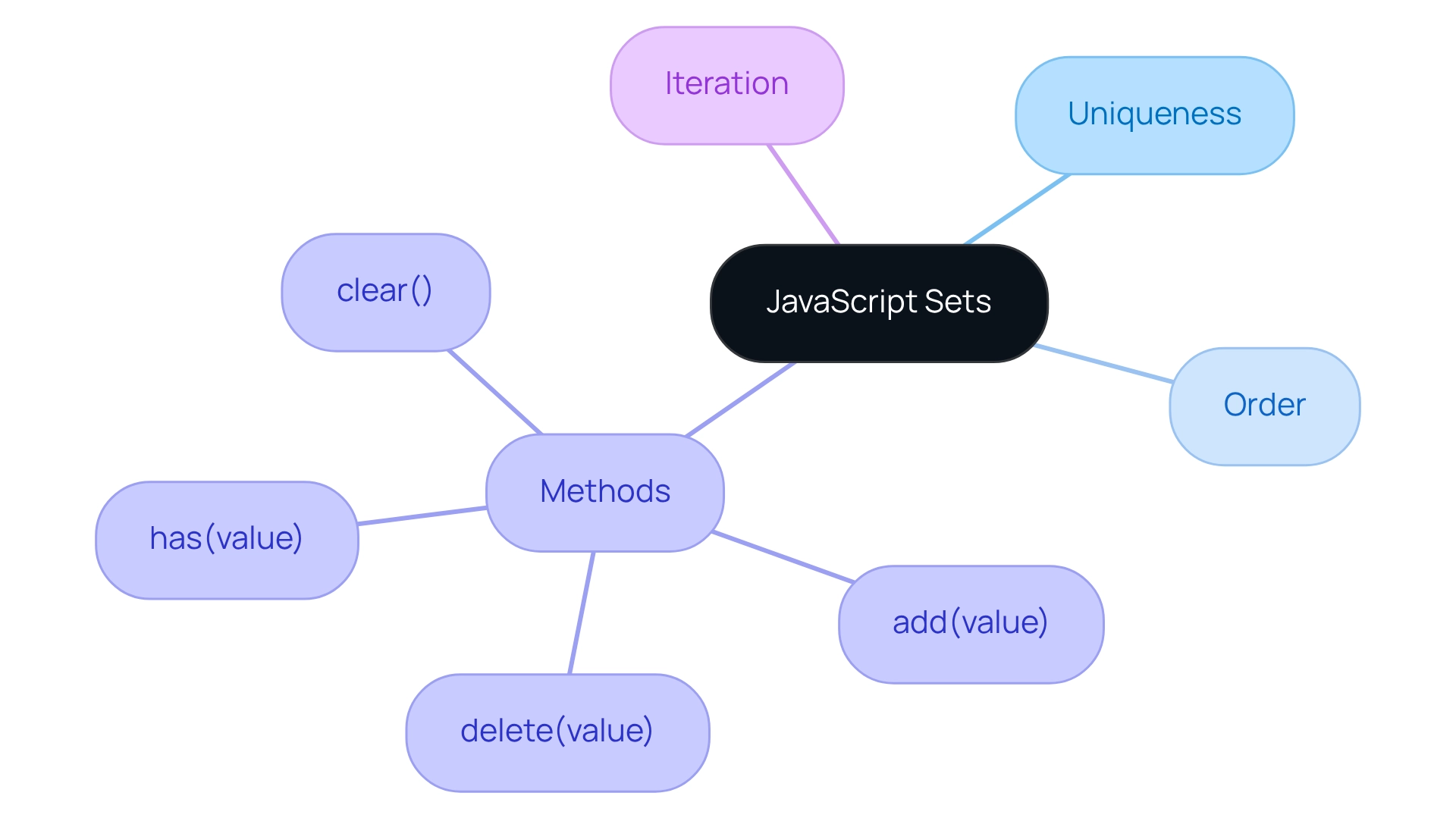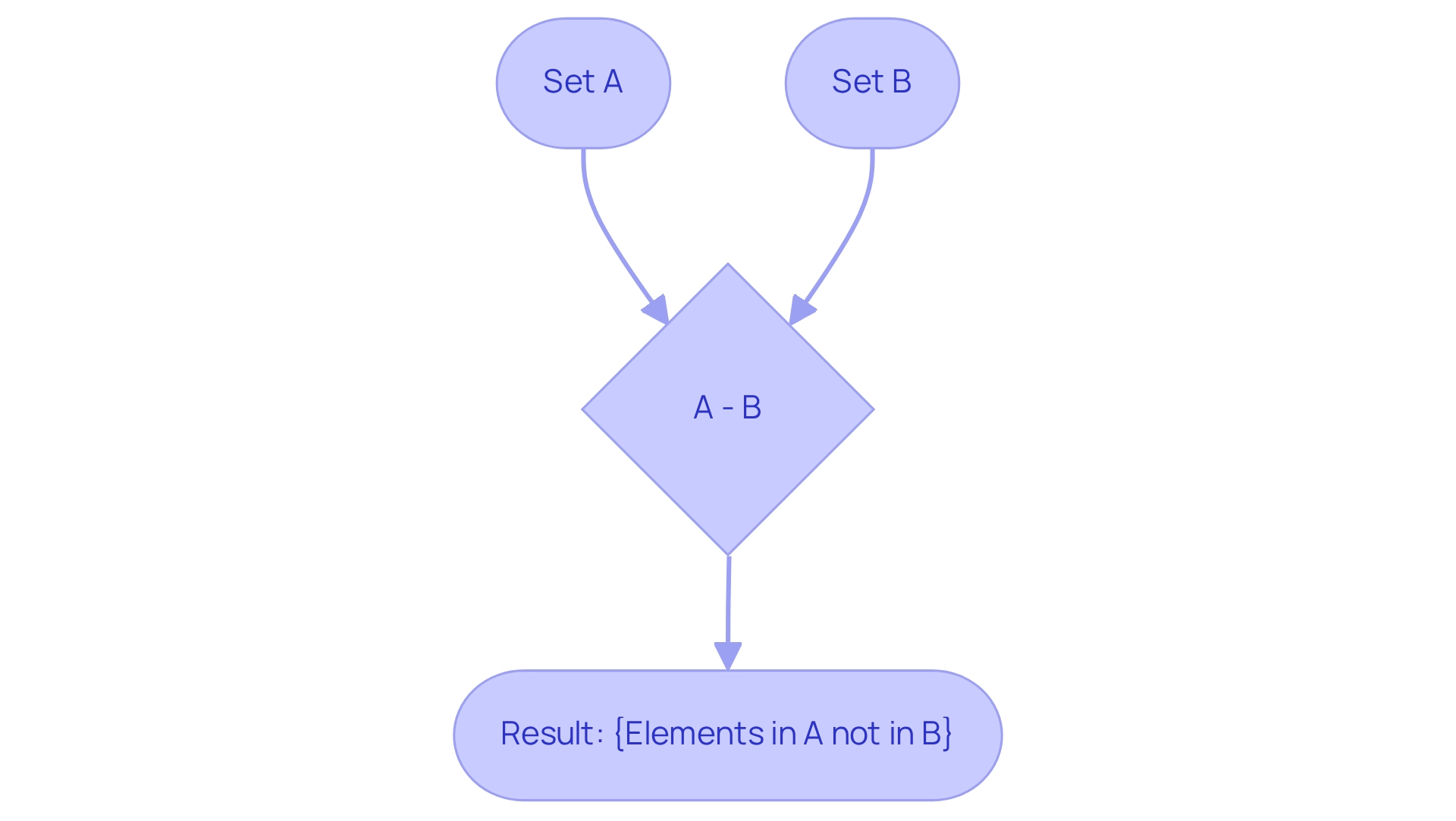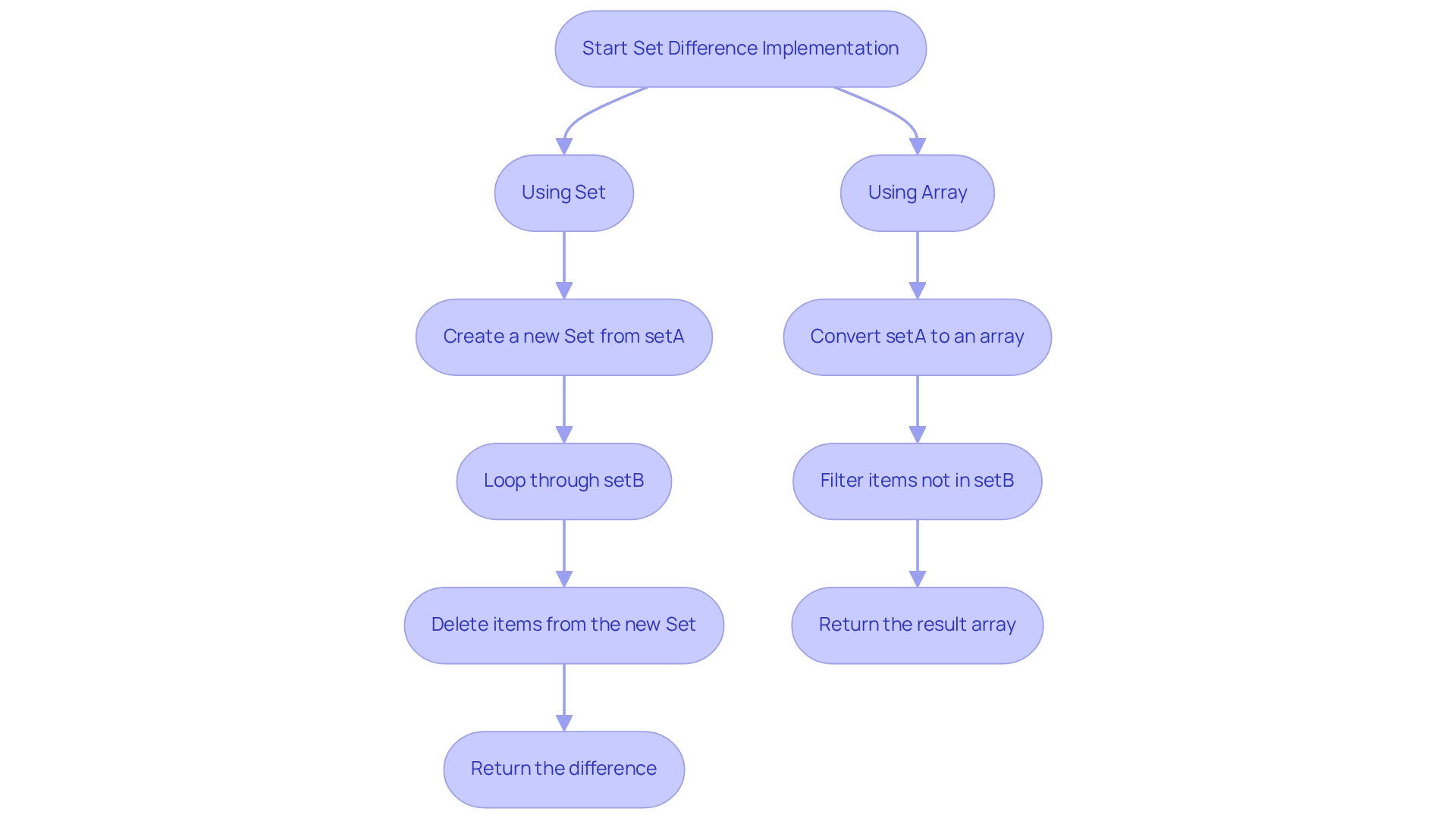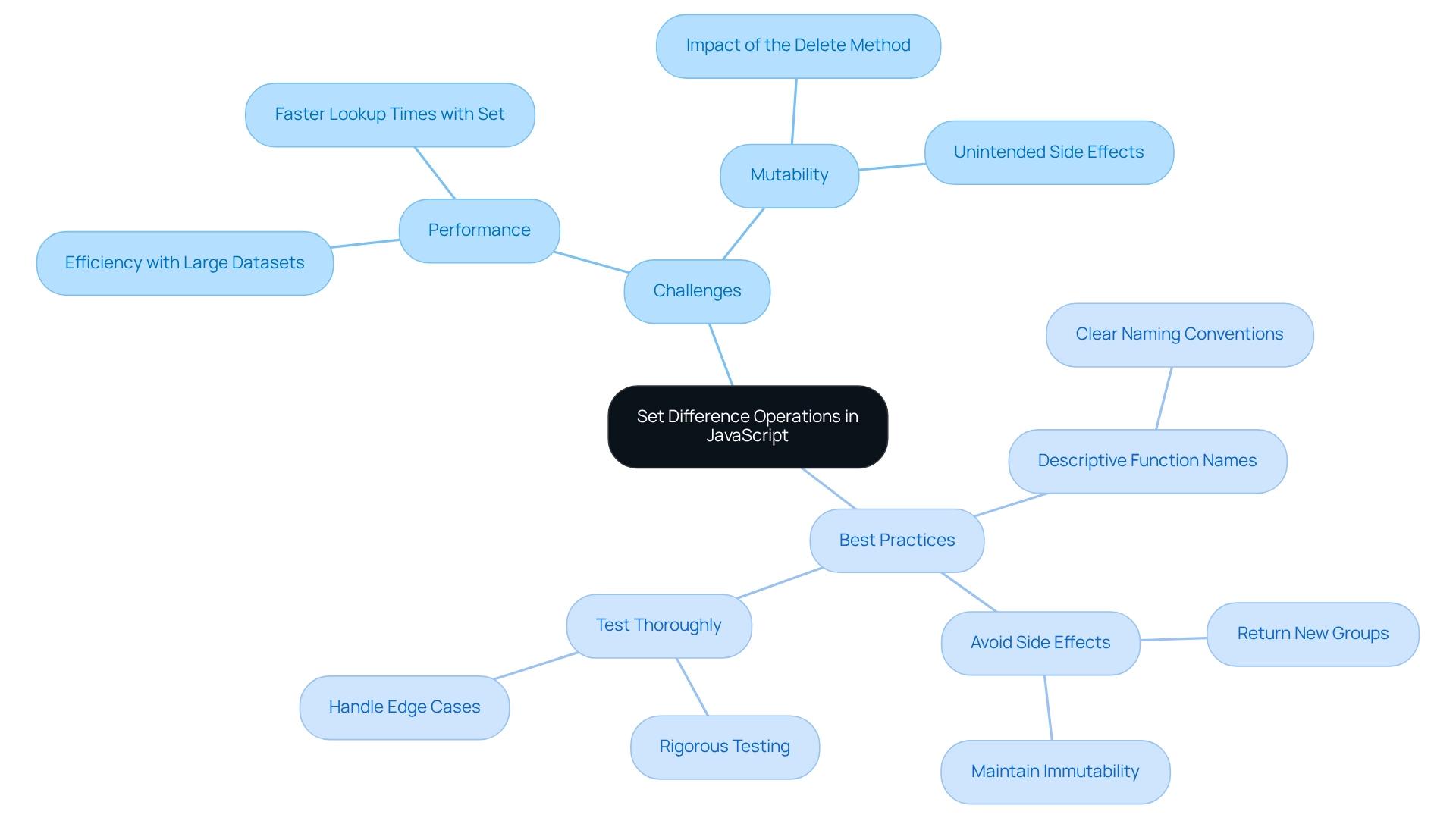Overview
The article addresses a common coding challenge faced by developers: mastering the JavaScript set difference. This concept involves creating a new set that contains elements unique to one set when compared to another. Understanding set operations is crucial for efficient data management in programming. The article explains this concept clearly, provides code examples for practical implementation, and discusses best practices. Furthermore, it emphasizes the importance of grasping these operations to enhance productivity and code quality. By exploring the nuances of set difference, developers can significantly improve their coding efficiency.
Introduction
In the realm of programming, developers often encounter significant challenges when managing collections of data efficiently. Have you ever struggled with ensuring the uniqueness of values in your datasets? JavaScript sets offer a powerful solution to these common issues. These built-in objects not only store unique values but also provide a variety of methods that enhance data manipulation.
By understanding the fundamentals of JavaScript sets, you can unlock their unique characteristics and leverage the concept of set difference—a crucial operation for effective data comparison and filtering. Furthermore, this article will provide practical code examples and address common challenges, equipping you with the knowledge needed to implement set difference effectively. By doing so, you will ensure that your data handling practices are both efficient and robust.
Explore JavaScript Sets: Fundamentals and Features
In the world of coding, developers often encounter challenges when managing collections of data, particularly when applying JavaScript set difference. JavaScript set difference offers a robust solution to these issues by allowing you to store unique elements of any kind, whether primitive types or object references. Here are some key features that make sets invaluable:
- Uniqueness: Each value in a set must be unique; duplicates are automatically removed.
- Order: Sets maintain the order of elements as they are added.
- Methods: Common methods include
add(value),delete(value),has(value), andclear(). For example:
const mySet = new Set();
mySet.add(1);
mySet.add(2);
mySet.add(1); // Duplicate, will not be added
console.log(mySet); // Output: Set { 1, 2 }
- Iteration: You can iterate over the elements of a set using a
for...ofloop or theforEachmethod.
Furthermore, grasping these basics is crucial for effectively employing collections in JavaScript programming. By mastering sets, you can enhance your coding efficiency and ensure better data management.

Define Set Difference: Concept and Importance
The javascript set difference is a fundamental operation that results in a new set containing elements found in one set but absent in another. Consider this: if you have two collections, A and B, the operation A - B (or A \ B) yields all elements of A that are not in B. This concept of javascript set difference is essential for developers dealing with common coding challenges, such as filtering data or comparing datasets. For instance, if A = {1, 2, 3} and B = {2, 3, 4}, then A - B = {1}. Furthermore, understanding javascript set difference can significantly enhance your ability to manipulate collections of data effectively. By leveraging this operation, you can implement algorithms that require distinct data handling, such as javascript set difference, ultimately improving your productivity and code quality. Have you considered how mastering such concepts can streamline your coding practices?
In addition, recognizing the importance of these operations can lead to more efficient data management strategies. For developers, the ability to utilize javascript set difference for filtering and comparing datasets is crucial. Thus, embracing set subtraction not only aids in immediate tasks but also fosters a deeper understanding of data manipulation techniques.

Implement Set Difference in JavaScript: Code Examples and Walkthrough
Coding challenges can often feel overwhelming for developers, especially when it comes to managing data structures like sets. Understanding how to implement JavaScript set difference can simplify these challenges significantly.
To address this, consider utilizing the Collection Object. You can develop a function that accepts two collections and returns the distinction. Here's how:
function setDifference(setA, setB) {
const difference = new Set(setA);
for (let item of setB) {
difference.delete(item);
}
return difference;
}
Example Usage:
const setA = new Set([1, 2, 3, 4]);
const setB = new Set([3, 4, 5]);
const result = setDifference(setA, setB);
console.log(result); // Output: Set { 1, 2 }
In addition, you can use Array methods to achieve the same result. By converting sets to arrays, you can utilize the filter method:
function setDifferenceArray(setA, setB) {
return [...setA].filter(item => !setB.has(item));
}
Example Usage:
const resultArray = setDifferenceArray(setA, setB);
console.log(resultArray); // Output: [1, 2]
These methods provide a clear and efficient way to compute the set difference in JavaScript, enhancing your coding productivity and code quality. Why not explore these tools and see how they can streamline your development process?

Address Challenges and Best Practices for Set Difference Operations
When tackling javascript set difference operations, developers often encounter specific challenges. Understanding these can significantly enhance coding efficiency.
Performance: For large datasets, utilizing the Set object is typically more efficient than arrays, thanks to faster lookup times. This makes collections the preferred choice for operations that involve uniqueness.
Mutability: Caution is essential when modifying collections. The delete method, for instance, alters the original set, which can lead to unintended side effects if not managed properly.
Best Practices:
- Use Descriptive Function Names: Clearly naming functions, such as
setDifference, helps convey their purpose effectively. - Avoid Side Effects: When manipulating collections, consider returning new groups instead of altering existing ones. This approach maintains immutability and reduces risks.
- Test Thoroughly: Rigorous testing of set operations with various datasets is crucial. Ensure your code can handle edge cases, including empty sets or those with duplicate values.
By adhering to these guidelines, developers can ensure that their javascript set difference operations are not only efficient but also reliable and maintainable. Why not explore how these best practices can streamline your coding experience?

Conclusion
Developers often face significant challenges in managing collections of unique values within their code. JavaScript sets offer a robust solution to these challenges, making them an invaluable tool. With their inherent uniqueness and efficient data manipulation methods, sets empower programmers to handle data more effectively. Moreover, understanding the concept of set difference enhances this capability, allowing for precise data filtering and comparison essential in various applications.
Implementing set difference in JavaScript can be straightforward, whether through the Set object or array methods. The provided code examples illustrate these techniques clearly and effectively. By mastering these implementations, developers can ensure their data handling is not only efficient but also accurate, leading to improved productivity and code quality.
However, addressing potential challenges and adhering to best practices when performing set difference operations is critical for maintaining code reliability. By prioritizing performance, managing mutability, and ensuring thorough testing, developers can create robust applications that effectively utilize the power of JavaScript sets. Ultimately, embracing these concepts will lead to more effective data management and a deeper understanding of JavaScript's capabilities. Are you ready to enhance your coding practices and explore the power of JavaScript sets?
Frequently Asked Questions
What is JavaScript set difference?
JavaScript set difference is a method that allows developers to manage collections of data by storing unique elements, whether they are primitive types or object references.
What are the key features of JavaScript sets?
The key features of JavaScript sets include:\n- Uniqueness: Each value must be unique; duplicates are automatically removed.\n- Order: Sets maintain the order of elements as they are added.\n- Methods: Common methods include add(value), delete(value), has(value), and clear().\n- Iteration: You can iterate over the elements using a for...of loop or the forEach method.
Can you provide an example of using a JavaScript set?
Yes, here is an example:\njavascript\nconst mySet = new Set();\nmySet.add(1);\nmySet.add(2);\nmySet.add(1); // Duplicate, will not be added\nconsole.log(mySet); // Output: Set { 1, 2 }\n
Why is it important to understand JavaScript sets?
Understanding JavaScript sets is crucial for effectively employing collections in programming, as it enhances coding efficiency and ensures better data management.




